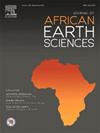苏丹北部Wadi Halfa地区基于机器学习的岩性填图及高光谱和多光谱遥感矿产勘探
IF 2.2
4区 地球科学
Q2 GEOSCIENCES, MULTIDISCIPLINARY
引用次数: 0
摘要
目前,全球对矿产资源的需求非常旺盛,导致各国将重点放在勘探上。遥感是一种具有成本效益的工具,特别是在恶劣的地形中。本研究在北苏丹的Wadi Halfa进行了岩性测绘,使用基于算法的遥感、实地观测和岩石学分析来探测铁矿石和重晶石矿床。整合多传感器光学数据集(L9、L8和S2),有效圈定岩性单元。此外,具有详细光谱特征的PRISMA高光谱数据改善了整个研究区域重晶石和氧化铁的空间分布模式。图像处理技术(假彩色复合材料、主成分分析、最小噪声摩擦、频带比)检测到含羟基矿物、铁和铁氧化物。支持向量机(SVM)、人工神经网络(ANN)和马哈拉诺比斯距离分类器(MDC)的总体准确率分别为95.51%、94.59%和98.99%。这项研究有助于解释重晶石和氧化铁之间的空间关系。通过野外调查、岩石学检查和经化学分析验证的遥感发现,确定了四种不同层数的铁矿,包括(a)鲕状铁矿、(b)含铁砂岩、(c)含铁铁矿和(d)带状铁地层(BIF),揭示了铁(62.7% Fe)和重晶石(63.9% Ba)的浓度。一项经济评估证实存在适合开采的经济储量。该研究被推荐用于更广泛的应用,特别是在复杂沉积序列中描绘铁矿石和重晶石矿床的机器学习中。机器学习算法的实现强调了它们在增强沉积序列岩性制图方面的潜力,为未来的研究提供了一个有希望的方向。本文章由计算机程序翻译,如有差异,请以英文原文为准。

Machine learning-based lithological mapping and mineral prospecting using hyperspectral and multispectral remote sensing in Wadi Halfa, north Sudan
At present, the global demand for mineral resources is critical, leading nations to focus on exploration. Remote sensing is a cost-effective tool, especially in harsh terrains. This study conducted lithological mapping in Wadi Halfa, North Sudan, using algorithm-based remote sensing, field observations, and petrographical analysis to detect iron ore and barite deposits. Multisensor optical datasets (L9, L8, and S2) were integrated to effectively delineate the lithological units. In addition, PRISMA hyperspectral data, with its detailed spectral signatures, improved spatial distribution patterns of barite and iron oxides across the study area. Image processing techniques (false colour composites, principal component analysis, minimum noise friction, band ratios) detected hydroxyl-bearing minerals, ferric, and ferrous oxides. Support Vector Machine (SVM), Artificial Neural Network (ANN), and Mahalanobis Distance Classifier (MDC) achieved overall accuracies of 95.51 %, 94.59 %, and 98.99 %, respectively. The study helped interpret the spatial relationship between barite and iron oxides. Four types of iron ore with more than three distinct layers were identified, including (a) oolitic ironstone, (b) ferruginous sandstone, (c) ferruginous ironstone, and (d) Banded Iron Formation (BIF) during field investigations, petrographic examinations, and chemical analysis validated remote sensing findings, revealing iron ore (62.7 % Fe) and barite (63.9 % Ba) concentrations. An economic assessment confirmed the presence of economic reserves suitable for exploitation. This research is recommended for broader application, particularly in machine learning for delineating iron ore and barite deposits in complex sedimentary sequences. The realization of machine learning algorithms emphasizes their potential to enhance lithological mapping in sedimentary sequences, suggesting a promising direction for future research.
求助全文
通过发布文献求助,成功后即可免费获取论文全文。
去求助
来源期刊

Journal of African Earth Sciences
地学-地球科学综合
CiteScore
4.70
自引率
4.30%
发文量
240
审稿时长
12 months
期刊介绍:
The Journal of African Earth Sciences sees itself as the prime geological journal for all aspects of the Earth Sciences about the African plate. Papers dealing with peripheral areas are welcome if they demonstrate a tight link with Africa.
The Journal publishes high quality, peer-reviewed scientific papers. It is devoted primarily to research papers but short communications relating to new developments of broad interest, reviews and book reviews will also be considered. Papers must have international appeal and should present work of more regional than local significance and dealing with well identified and justified scientific questions. Specialised technical papers, analytical or exploration reports must be avoided. Papers on applied geology should preferably be linked to such core disciplines and must be addressed to a more general geoscientific audience.
 求助内容:
求助内容: 应助结果提醒方式:
应助结果提醒方式:


